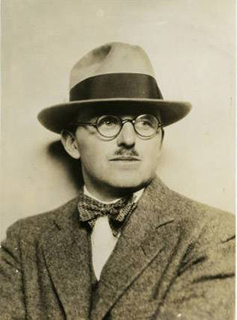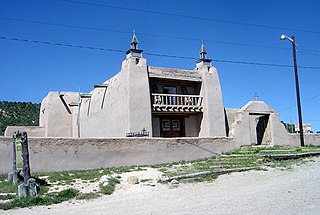
The University of New Mexico is a public research university in Albuquerque, New Mexico, United States. Founded in 1889 by the New Mexico Territorial Legislature, it is the state's second oldest university, a flagship university in the state, and the largest by enrollment, with 22,630 students in 2023.

San Felipe de Neri Church is a historic Catholic church located on the north side of Old Town Plaza in Albuquerque, New Mexico. Built in 1793, it is one of the oldest surviving buildings in the city and the only building in Old Town proven to date to the Spanish colonial period. The church is listed on the New Mexico State Register of Cultural Properties and the National Register of Historic Places and has remained in continuous use for over 200 years.

John Gaw Meem IV was an American architect based in Santa Fe, New Mexico. He is best known for his instrumental role in the development and popularization of the Pueblo Revival Style and as a proponent of architectural Regionalism in the face of international modernism. Meem is regarded as one of the most important and influential architects to have worked in New Mexico.

The Pueblo Revival style or Santa Fe style is a regional architectural style of the Southwestern United States, which draws its inspiration from Santa Fe de Nuevo México's traditional Pueblo architecture, the Spanish missions, and Territorial Style. The style developed at the beginning of the 20th century and reached its greatest popularity in the 1920s and 1930s, though it is still commonly used for new buildings. Pueblo style architecture is most prevalent in the state of New Mexico; it is often blended with Territorial Revival architecture.

The Estufa is a historic structure on the University of New Mexico campus in Albuquerque, New Mexico. It was built in 1907–08 by a local social fraternity and has served since 1915 as the primary meeting location of the university's Pi Kappa Alpha chapter. The building's history is steeped in fraternity lore and supposedly no woman has ever seen its interior. It is listed in both the New Mexico State Register of Cultural Properties and the National Register of Historic Places.

The San Jose de Gracia Church, also known as Church of Santo Tomas Del Rio de Las Trampas, is a historic church on the main plaza of Las Trampas, New Mexico. Built between 1760 and 1776, it is one of the least-altered examples of a Spanish Colonial Pueblo mission church, with adobe walls rising 34 feet (10 m) in height. It was declared a National Historic Landmark in 1970.
Zimmerman Field was a stadium located in Albuquerque, New Mexico. It opened in 1938 and hosted the University of New Mexico Lobos football team until they moved to University Stadium in 1960. The stadium continued in use for intramural sports until 1969, when it was demolished to make way for new academic facilities.

Vigas are wooden beams used in the traditional adobe architecture of the American Southwest, especially in New Mexico. In this type of construction, the vigas are the main structural members carrying the weight of the roof to the load-bearing exterior walls. The exposed beam-ends projecting from the outside of the wall are a defining characteristic of Pueblo architecture and of Spanish Colonial architecture in New Mexico, often replicated in modern Pueblo Revival architecture. Usually the vigas are simply peeled logs with a minimum of woodworking. In traditional buildings, the vigas support latillas (laths) which are placed crosswise and upon which the adobe roof is laid, often with intermediate layers of brush or soil. The latillas may be hewn boards, or - in more rustic buildings - simply peeled branches. These building techniques date back to the Ancestral Puebloan peoples of 750 to 1300 CE, and vigas are visible in many of their surviving buildings.

Bainbridge Bunting was an American architectural historian, teacher, and author.

Territorial Revival architecture describes the style of architecture developed in the U.S. state of New Mexico in the 1930s. It derived from New Mexico vernacular Territorial Style, an original style from Santa Fe de Nuevo México following the founding of Albuquerque in 1706. Territorial Revival incorporated elements of traditional regional building techniques with higher style elements. The style was intended to recall the Territorial Style and was extensively employed for New Mexico state government buildings in Santa Fe.

Taylor Memorial Chapel at La Foret Conference and Retreat Center is a historic chapel in Black Forest, Colorado. It is a National Register of Historic Places listing.

Carlisle Gymnasium is an indoor arena on the campus of the University of New Mexico in Albuquerque, New Mexico. It was the home of the New Mexico Lobos basketball team from its opening in 1928 until the completion of the larger Johnson Gymnasium in 1957, and was also the original venue of the New Mexico Symphony Orchestra. The building currently houses the university's Elizabeth Waters Center for Dance.

Hodgin Hall, previously known at various times as the University Building, Main Building, or Administration Building, is a historic building on the University of New Mexico campus in Albuquerque, New Mexico. Completed in 1892, it was the first building constructed on the UNM campus and the university's only building for almost a decade. The building was originally designed by Jesse Wheelock in the Richardsonian Romanesque style, but structural problems with the building's roof gave university president William Tight the opportunity to have it remodeled in his preferred Pueblo Revival style in 1908.

The Art Annex is a historic building on the campus of the University of New Mexico in Albuquerque, New Mexico. Built in 1926, it originally served as the university's library. The building was designed by Trost & Trost and Elson H. Norris and features a Mayan-influenced hybrid form of Pueblo Revival architecture. It was listed in the New Mexico State Register of Cultural Properties in 1975 and the National Register of Historic Places in 1988.

Cristo Rey Church is a Roman Catholic parish church on Canyon Road in Santa Fe, New Mexico. It is one of the most notable buildings designed by influential Santa Fe architect John Gaw Meem and is claimed by some sources to be the largest adobe building in the United States. It is also notable for its historic altar screen, the Reredos of Our Lady of Light, which is listed on the National Register of Historic Places. The reredos was carved in 1761 and originally hung in La Castrense, a military chapel on the Santa Fe Plaza. It has been described as "one of the most extraordinary pieces of ecclesiastical art in the country". The church was dedicated in 1940.

President's House, in Albuquerque, New Mexico on the University of New Mexico campus at the northeast corner of Roma Ave. and Yale Blvd., was built in 1930. It is now known as University House. It was designed by architect Miles Brittelle in Spanish Pueblo Revival style. It was listed on the New Mexico State Register of Cultural Properties and the National Register of Historic Places in 1988.

The Albuquerque Veterans Administration Medical Center, at 2100 Ridgecrest, SE, in Albuquerque, New Mexico, was built in 1932. It was listed on the National Register of Historic Places in 1983. The listing included 16 contributing buildings and a contributing structure on 40 acres (16 ha).

Van Dorn Hooker was an American architect and the University Architect for the University of New Mexico from 1963 to 1987.

The Jonson Gallery is a historic building on the campus of the University of New Mexico in Albuquerque, New Mexico, which was completed in 1950 as a combination home and gallery for the modernist painter Raymond Jonson. During Jonson's lifetime and afterwards, the gallery was a center for modern and abstract art in New Mexico, as well as housing a large collection of Jonson's own works. In 2009, the gallery's collections were absorbed into the University of New Mexico Art Museum and the former gallery building was converted to office space.

Zimmerman Library is the historic main library of the University of New Mexico, located near the center of the university campus in Albuquerque, New Mexico. It is one of the largest and most notable buildings designed by New Mexico architect John Gaw Meem and is the centerpiece of the UNM Libraries, the largest library system in New Mexico with almost 4 million print volumes. It was built in 1936–38 with funding from the Public Works Administration and Works Progress Administration, with further additions completed in 1966 and 1973. The building was named for former university president James Fulton Zimmerman in 1961. It was added to the New Mexico State Register of Cultural Properties and the National Register of Historic Places in 2016.






















